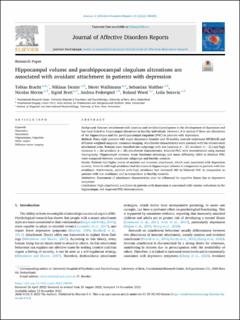Please use this identifier to cite or link to this item:
https://doi.org/10.21256/zhaw-29656Full metadata record
| DC Field | Value | Language |
|---|---|---|
| dc.contributor.author | Bracht, Tobias | - |
| dc.contributor.author | Denier, Niklaus | - |
| dc.contributor.author | Wallimann, Meret | - |
| dc.contributor.author | Walther, Sebastian | - |
| dc.contributor.author | Mertse, Nicolas | - |
| dc.contributor.author | Breit, Sigrid | - |
| dc.contributor.author | Federspiel, Andrea | - |
| dc.contributor.author | Wiest, Roland | - |
| dc.contributor.author | Soravia, Leila | - |
| dc.date.accessioned | 2024-01-27T13:24:22Z | - |
| dc.date.available | 2024-01-27T13:24:22Z | - |
| dc.date.issued | 2022 | - |
| dc.identifier.issn | 2666-9153 | de_CH |
| dc.identifier.uri | https://digitalcollection.zhaw.ch/handle/11475/29656 | - |
| dc.description.abstract | Background: Insecure attachment style (anxious and avoidant) predisposes to the development of depression and has been linked to hippocampal alterations in healthy individuals. However, it is unclear if there are alterations of the hippocampus and the parahippocampal cingulum (PHC) in patients with depression. Methods: Forty-eight patients with major depressive disorder and 18 healthy controls underwent MP2RAGE and diffusion-weighted magnetic resonance imaging. Attachment characteristics were assessed with the revised adult attachment scale. Patients were classified into subgroups with low (anxious: n = 27; avoidant: n = 21) and high (anxious: n = 20; avoidant: n = 28) attachment characteristics. Bilateral PHC were reconstructed using manual tractography. Hippocampal volumes, mean fractional anisotropy and mean diffusivity (MD) in bilateral PHC were compared between attachment subgroups and healthy controls. Results: Patients had higher scores of anxious and avoidant attachment, which were associated with depression severity. Patients with high avoidance had decreases in hippocampal volumes in comparison to patients with low avoidance. Furthermore, patients with high avoidance had increased MD in bilateral PHC in comparison to patients with low avoidance and in comparison to healthy controls. Limitations: Assessment of attachment characteristics may be influenced by cognitive biases due to depressive symptoms Conclusions: High attachment avoidance in patients with depression is associated with volume reductions in the hippocampus and impaired PHC-microstructure. | de_CH |
| dc.language.iso | en | de_CH |
| dc.publisher | Elsevier | de_CH |
| dc.relation.ispartof | Journal of Affective Disorders Reports | de_CH |
| dc.rights | http://creativecommons.org/licenses/by-nc-nd/4.0/ | de_CH |
| dc.subject | Depression | de_CH |
| dc.subject | Attachment | de_CH |
| dc.subject | Hippocampus | de_CH |
| dc.subject | Cingulum | de_CH |
| dc.subject | White matter | de_CH |
| dc.subject | Diffusion tensor imaging | de_CH |
| dc.subject.ddc | 616.8: Neurologie und Krankheiten des Nervensystems | de_CH |
| dc.title | Hippocampal volume and parahippocampal cingulum alterations are associated with avoidant attachment in patients with depression | de_CH |
| dc.type | Beitrag in wissenschaftlicher Zeitschrift | de_CH |
| dcterms.type | Text | de_CH |
| zhaw.departement | Soziale Arbeit | de_CH |
| zhaw.organisationalunit | Institut für Kindheit, Jugend und Familie (IKJF) | de_CH |
| dc.identifier.doi | 10.1016/j.jadr.2022.100435 | de_CH |
| dc.identifier.doi | 10.21256/zhaw-29656 | - |
| zhaw.funding.eu | No | de_CH |
| zhaw.issue | 100435 | de_CH |
| zhaw.originated.zhaw | Yes | de_CH |
| zhaw.publication.status | publishedVersion | de_CH |
| zhaw.volume | 10 | de_CH |
| zhaw.publication.review | Peer review (Publikation) | de_CH |
| zhaw.author.additional | No | de_CH |
| zhaw.display.portrait | Yes | de_CH |
| Appears in collections: | Publikationen Soziale Arbeit | |
Files in This Item:
| File | Description | Size | Format | |
|---|---|---|---|---|
| 2022_Bracht-etal_Hippocampal-volume-parahippocampal-cingulum-alterations.pdf | 2.2 MB | Adobe PDF |  View/Open |
Show simple item record
Bracht, T., Denier, N., Wallimann, M., Walther, S., Mertse, N., Breit, S., Federspiel, A., Wiest, R., & Soravia, L. (2022). Hippocampal volume and parahippocampal cingulum alterations are associated with avoidant attachment in patients with depression. Journal of Affective Disorders Reports, 10(100435). https://doi.org/10.1016/j.jadr.2022.100435
Bracht, T. et al. (2022) ‘Hippocampal volume and parahippocampal cingulum alterations are associated with avoidant attachment in patients with depression’, Journal of Affective Disorders Reports, 10(100435). Available at: https://doi.org/10.1016/j.jadr.2022.100435.
T. Bracht et al., “Hippocampal volume and parahippocampal cingulum alterations are associated with avoidant attachment in patients with depression,” Journal of Affective Disorders Reports, vol. 10, no. 100435, 2022, doi: 10.1016/j.jadr.2022.100435.
BRACHT, Tobias, Niklaus DENIER, Meret WALLIMANN, Sebastian WALTHER, Nicolas MERTSE, Sigrid BREIT, Andrea FEDERSPIEL, Roland WIEST und Leila SORAVIA, 2022. Hippocampal volume and parahippocampal cingulum alterations are associated with avoidant attachment in patients with depression. Journal of Affective Disorders Reports. 2022. Bd. 10, Nr. 100435. DOI 10.1016/j.jadr.2022.100435
Bracht, Tobias, Niklaus Denier, Meret Wallimann, Sebastian Walther, Nicolas Mertse, Sigrid Breit, Andrea Federspiel, Roland Wiest, and Leila Soravia. 2022. “Hippocampal Volume and Parahippocampal Cingulum Alterations Are Associated with Avoidant Attachment in Patients with Depression.” Journal of Affective Disorders Reports 10 (100435). https://doi.org/10.1016/j.jadr.2022.100435.
Bracht, Tobias, et al. “Hippocampal Volume and Parahippocampal Cingulum Alterations Are Associated with Avoidant Attachment in Patients with Depression.” Journal of Affective Disorders Reports, vol. 10, no. 100435, 2022, https://doi.org/10.1016/j.jadr.2022.100435.
Items in DSpace are protected by copyright, with all rights reserved, unless otherwise indicated.